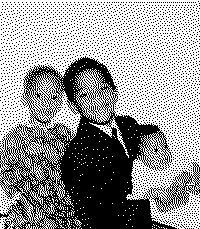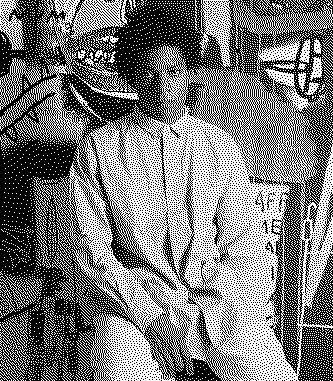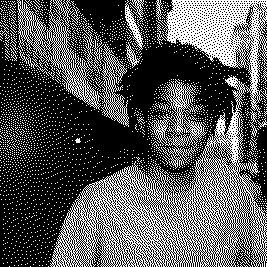Artists/Jean-Michel Basquiat
Fast Facts
Neo Expressionism
Seminal member of Neo-Expressionist movement of the 1980s.
Graffiti Beginnings
Basquiat started his artistic career as a graffiti artist in New York City under the pseudonym "SAMO," which stood for "Same Old Shit." This early work was characterized by its witty phrases and social commentary.
Collaboration with Andy Warhol
Basquiat famously collaborated with artist Andy Warhol, which resulted in a series of works that combined Basquiat's raw, expressive style with Warhol's more polished pop art aesthetic.
Themes of Race and Identity
Basquiat's art frequently explored themes related to his African-American heritage, tackling issues of race, inequality, and identity. His work provided a critical commentary on the socio-political environment of the time.
Use of Recycled Materials
He often painted on unconventional materials, including wood panels, doors, and windows, reflecting his interest in repurposing found objects and materials in his work.
Influence of Music and Culture
His art was heavily influenced by jazz, hip-hop, and the urban culture of New York City. References to music, especially jazz and blues, are a recurring element in his works.
Iconic Symbols
Common symbols in Basquiat's work include crowns, which he used to signify majesty or to celebrate black figures; skulls, often as a memento mori; and anatomical drawings, reflecting his interest in the human form and mortality.
Biography



Jean-Michel Basquiat, born on December 22, 1960, in Brooklyn, New York, was an influential American artist known for his raw, expressive works that combined elements of street art andAbstract Expressionism.
He was the son of a Haitian-American father and a Puerto Rican mother, which contributed to his diverse cultural background and influenced his artistic perspective. From an early age, Basquiat displayed a talent for art, encouraged by his mother, who took him to museums and supported his creative endeavors. However, his childhood was also marked by hardship, including his parents' separation and his mother's mental illness, which led him to leave home at a young age.
Basquiat's career began in the late 1970s under the pseudonym SAMO, a tag he used to graffiti enigmatic messages across lower Manhattan. His graffiti art quickly gained attention in the New York City art scene, and by the early 1980s, he had transitioned to painting on canvas. His works were characterized by their vibrant colors, chaotic compositions, and the incorporation of text and symbols, reflecting his experiences and observations of race, identity, and societal issues. Basquiat often included references to African-American history, pop culture, and classical themes, creating a unique and powerful visual language .
In 1981, Basquiat's breakthrough came when he was included in the seminal "New York/New Wave" exhibition at P.S.1 Contemporary Art Center. This exposure led to his first solo exhibition in 1982 at the Annina Nosei Gallery. That same year, he participated in Documenta 7 in Kassel, Germany, becoming one of the youngest artists to exhibit there. His meteoric rise continued as he formed a notable friendship and artistic collaboration with Andy Warhol, which brought him further into the spotlight. Despite his rapid success, Basquiat struggled with the pressures of fame, the exploitation of his work, and personal demons, including substance abuse.
Basquiat's life was tragically cut short when he died of a heroin overdose on August 12, 1988, at the age of 27. Despite his brief career, his impact on the art world was profound and lasting. Basquiat's work challenged traditional art hierarchies and brought the energy of the streets into the galleries. His legacy is preserved through the enduring relevance of his art, which continues to be celebrated and studied for its innovative style and powerful social commentary. Basquiat remains a symbol of the vibrant and transformative power of contemporary art.
Sources:
"Basquiat: A Quick Killing in Art" by Phoebe Hoban.
"Jean-Michel Basquiat" by Leonhard Emmerling.
"Basquiat" (Film) directed by Julian Schnabel.
"Jean-Michel Basquiat: 1981–1983" by Marc Mayer.
"Basquiat and the Defining Years" by Eleanor Nairne.
"Jean-Michel Basquiat" by Dieter Buchhart.
"The Radiant Child" (Documentary) directed by Tamra Davis.
"Jean-Michel Basquiat: Now's the Time" by Dieter Buchhart and Alison G. Madigan.
Iconic Imagery
- Crown Symbolism
- Text and Words
- Figurative Anatomy
- Historical and Cultural References
- Social and Political Commentary
Bodies of Work
-

Early SAMO Graffiti
-

Policemen & Police Brutality
1981–1983
-

Boxer Paintings
-

Famous African American Athletes
-

Stretcher Bar Paintings
-

Anatomical Paintings
-

Kings
-

Prophets
1981–1982
-

Warrior Paintings
-

The Figure Portfolio
-

Self-Portraits
-

Portraits
-

Animals
-

Cars
-

Cityscapes
-

Daros Suite
1982–2983
-

Superheroes
1982–1987
-

Crown Paintings
-

Jazz Paintings
-

Entertainment Industry
-

Griot Paintings
-

Modena Paintings
-

Made in Japan
1982
-

Skull Paintings
1982–1983
-

Beat Bop (Rammellzee Album Cover)
1983
-

11 Blue Ribbon Paintings
1984
-

The Offs’ First Album Cover
1984
-

Collaboration Paintings with Francesco Clemente and Andy Warhol
1984
-

Collaboration paintings with Andy Warhol
1984–1985
-

Xerox Paintings
1985–1986
-

Late Works
1987–1988
Importance
Pioneering Street Art in Fine Art
Basquiat was one of the first artists to successfully transition from street art to the fine art world. His graffiti roots, under the pseudonym "SAMO," brought the raw energy and immediacy of urban street culture into galleries and museums, helping to elevate graffiti as a legitimate art form (Tate).
Cultural Commentary
Basquiat's work is known for its powerful commentary on race, identity, and social issues. He often addressed the struggles and injustices faced by African Americans, drawing from his own experiences as a black artist in a predominantly white art world. His paintings frequently incorporate symbols, text, and imagery that critique colonialism, systemic racism, and inequality (MoMA).
Innovation in Artistic Style
Basquiat's unique style blends elements of primitivism, neo-expressionism, and abstract expressionism. His work is characterized by bold colors, chaotic compositions, and a fusion of text and image, creating a distinctive visual language that has influenced numerous artists. His ability to mix high and low culture, integrating elements of popular culture with profound historical references, set him apart as an innovative and boundary-pushing artist (Guggenheim).
Collaboration with Andy Warhol
Basquiat's collaboration with Andy Warhol was a significant moment in contemporary art. Their partnership produced a series of works that juxtaposed Warhol's pop art sensibilities with Basquiat's raw, expressive style. This collaboration not only highlighted Basquiat's versatility but also bridged different art movements, creating a dialogue between generations of artists (Whitney Museum).
Enduring Influence and Legacy
Basquiat's influence extends beyond the art world into popular culture. His life and work have been the subject of numerous books, documentaries, and films. His art continues to command high prices at auctions, reflecting its enduring appeal and significance. Basquiat's legacy as a trailblazer for artists of color and his contributions to contemporary art remain deeply influential (Art Institute of Chicago).
Representation and Diversity
As one of the few prominent black artists in the 1980s art scene, Basquiat's success broke racial barriers and paved the way for greater diversity in the art world. His presence and achievements challenged the traditional narratives and demographics of the art community, encouraging greater representation and inclusion (The Broad).
Technique
Jean-Michel Basquiat's technique was distinct and multifaceted, reflecting his background in graffiti and his innovative approach to painting and drawing.
Graffiti Influence
Basquiat's early work as a graffiti artist significantly influenced his painting style. He incorporated the raw, spontaneous, and bold aesthetic of street art into his canvases, often using spray paint and markers alongside traditional painting materials (MoMA).
Text and Symbolism
One of Basquiat's signature techniques was the integration of text and symbols into his artwork. He often included words, phrases, numbers, and symbols, which added layers of meaning and commentary. These elements were drawn from various sources, including literature, history, and popular culture (Whitney Museum).
Layering and Overpainting
Basquiat's paintings are characterized by their dense layering of imagery and text. He would frequently paint over previous layers, creating a palimpsest effect that conveyed depth and complexity. This technique added a dynamic and chaotic quality to his work (Tate).
Primitivism and Neo-Expressionism
Basquiat's style is often associated with primitivism and neo-expressionism. He drew inspiration from African, Caribbean, and other indigenous art forms, which he fused with the raw, emotional intensity of neo-expressionism. This blend resulted in a powerful, visceral visual language (Guggenheim).
Bold Color Palette
Basquiat used a vibrant and bold color palette in his work. His choice of colors was often striking and unconventional, enhancing the emotional impact and visual intensity of his paintings (The Broad).
Drawing and Line Work
Basquiat's drawing skills were a fundamental part of his technique. He used strong, expressive lines to create figures, faces, and other elements, often with a childlike, spontaneous quality. This approach gave his work a sense of immediacy and authenticity (Art Institute of Chicago).
Collage and Mixed Media
Basquiat frequently incorporated collage elements and mixed media into his paintings. He used found objects, photographs, and various materials to add texture and context to his work, enriching the narrative and visual complexity (Guggenheim).
Timeline
- Late 1970s - Early 1980s
Early Life and Graffiti Art
In the 1970s, Jean-Michel Basquiat was just starting his career as an artist. Before he rose to fame in the art world, he was a graffiti artist in Lower Manhattan. He worked under the pseudonym "SAMO©" (a contraction of "Same Old Shit"), along with his high school friend Al Diaz.
- Late 1980's
Breakthrough and Neo-Expressionist Works
- 1980s
Collaboration with Andy Warhol
- Late 1980s
Late Works and Legacy
























